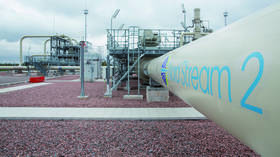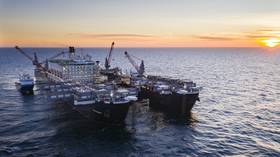‘Vladimir Putin’s pipeline weapon’: What’s really going on with Nord Stream 2?

The delivery of Russian natural gas to Europe via the Nord Stream 2 pipeline is likely to be delayed for another six months, Germany’s ambassador to Ukraine said on Monday.
The mega-project, completed in September after numerous roadblocks, is still far from supplying European customers, due to approval hurdles in the EU.
What is Nord Stream 2?
The 1,230-kilometer-long route is a new export gas pipeline running from Russia across the Baltic Sea to Germany. It runs parallel to the existing Nord Stream pipeline which became operational in 2012. Pipelaying operations for Nord Stream 2 commenced in September 2018. The total capacity of the pipeline’s two strings is 55 billion cubic meters of gas per year, which will ensure a highly reliable and cheap supply of Russian gas to Europe.
Who owns the pipeline?
Besides Russian energy major Gazprom, which has a majority stake in the project, the international consortium involved in the pipeline includes European firms such as Germany’s Wintershall and Uniper groups, the Dutch-British giant Shell, France’s Engie and Austria’s OMV. Gazprom is a 51% shareholder in the Swiss-based company Nord Stream AG, which manages the pipeline’s construction.
Who is against Nord Stream 2?
The construction of Nord Stream 2 has been strongly criticized by the US and some Eastern European countries, particularly Poland and Ukraine, who claim the project will increase Europe’s reliance on Russia for its energy needs. Opponents also voiced concerns that the new pipeline bypasses Ukraine, thus enabling Russia to cut down on gas transit through the country via its Soviet-era pipeline network.
READ MORE: Germany’s future Vice-Chancellor slams Nord Stream 2 as ‘project to pressure Ukraine’
The US administration has been one of the most vocal critics, attempting to derail the project and at the same time, boost sales of American liquefied natural gas (LNG) to the continent. The project has been criticized by US think tanks and has been dubbed by the Atlantic Council as “Vladimir Putin’s pipeline weapon.”
Who is in favor of the project?
Besides Russia, Europe’s biggest economy – Germany – remains firm as Nord Stream 2’s strongest backer, insisting that the pipeline will ensure the continent’s energy security. Berlin has rejected all concerns, saying that Nord Stream 2 is a commercial project. Outgoing Chancellor Angela Merkel has repeatedly reminded her European neighbors that Germany and Europe bought gas from Russia even at the height of the Cold War. Most Central and Western European countries are in favor of the project as well.
What steps did US take to stop Nord Stream 2?
In a bid to halt the construction of Nord Stream 2, Washington has levied a number of sanctions against its construction, and threatened foreign firms working on the project. As a result, a number of insurers and high-tech Western vessels laying pipes pulled out of the project, delaying the completion of the pipeline.
Have the delay tactics worked?
Work on the $10-billion pipeline had been suspended for nearly a year because of the US sanctions, which threatened asset freezes and visa restrictions for companies involved in the construction. In late 2019, after months of delays, Denmark gave the green light for the pipeline to pass through its waters. Copenhagen’s delay in granting permission was another hurdle to completing the project on time.
What were the consequences of the delay in Nord Stream 2’s construction?
The delays allowed time for EU to include the Nord Stream 2 project in its gas directive, which forbids the same company from delivering and selling gas within the Union. Inclusion in the law forces the project operator to sell parts of its business after making massive investments. The project would have been given an exemption had it been completed on time.
The consequences for Europe include less reliable deliveries of cheaper pipeline gas from Russia as traditional supplies from Norway are drying up. It also means greater reliance on imports of more expensive liquefied natural gas from the US and the Middle East. Gas prices across the continent have spiked to record highs in recent months due to a shortage of reserves in European underground storage facilities. The result is higher energy costs for the European consumer.
Why is the pipeline still not pumping gas?
The Nord Stream 2 is complete and filled with gas but not operational, as German officials have blocked its certification process. Germany's network regulator suspended its ongoing process to certify the pipeline after ruling that the operator must only be registered as a German entity, while Nord Stream 2 AG is based in Switzerland.
The regulator said this month the certification will be paused until the company behind it reorganizes in accordance with German law. The regulator will be able to resume its examination “in the remainder of the four-month period set out in law,” it said. Therefore, the previous January 8, 2022 deadline for the certification of Nord Stream 2 has been delayed once again.
For more stories on economy & finance visit RT's business section













